Vateria macrocarpa Gupta
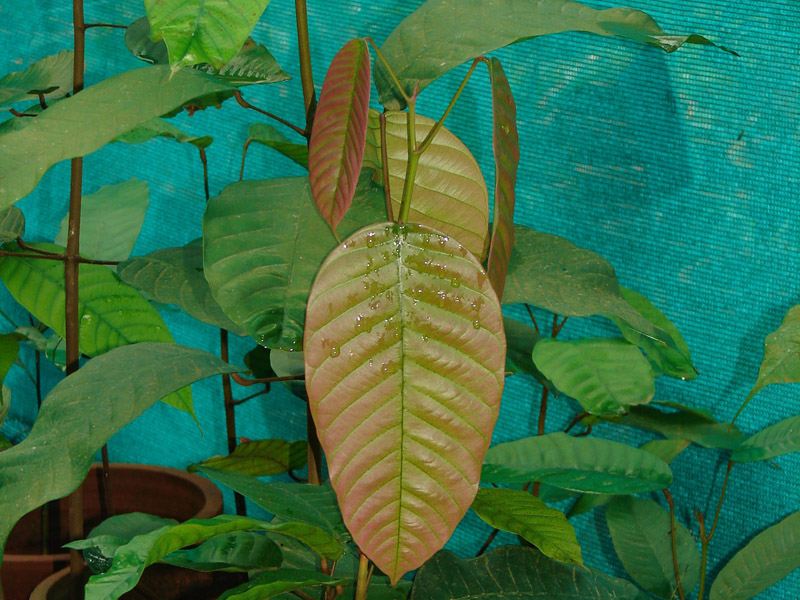
Common name: Valiya-vellapayin, Perumpain
Family: Dipterocarpaceae
Distribution: Endemic to Southern Western Ghats, restricted to Attapadi hills of Palakkad district, Kerala
Conservation status: Critically Endangered (CR- IUCN Red list), in restricted populations only
Description: Large evergreen trees near stream sides. Resinous exudates present. Flowers white in axillary panicles; peduncle and pedicel densely pubescent. Fruit a large ovoid capsule, 8-12 cm lonf, 4-5 cm diameter, seed one.
Uses: Soft Wood, not much utilised
Hopea erosa (Bedd.) Slooten
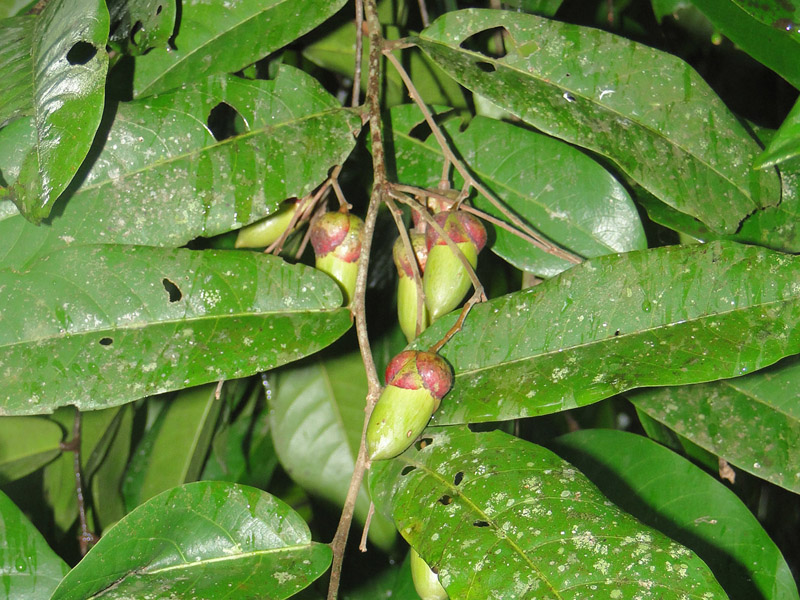
Common name: Eeyakam, Karakongu
Family: Dipterocarpaceae
Distribution: Endemic to Western Ghats, in Tamil Nadu and Kerala.
Conservation status: Critically Endangered (CR- IUCN Red list)
Description: Large trees. Leaves oblanceolate, acute at apex. Flowers greyish yellow in unilateral racemed panicles. Fruit an ovoid nut, with accresent woody calyx.
Uses: Hard timber
Aglaia malabarica Sasidharan
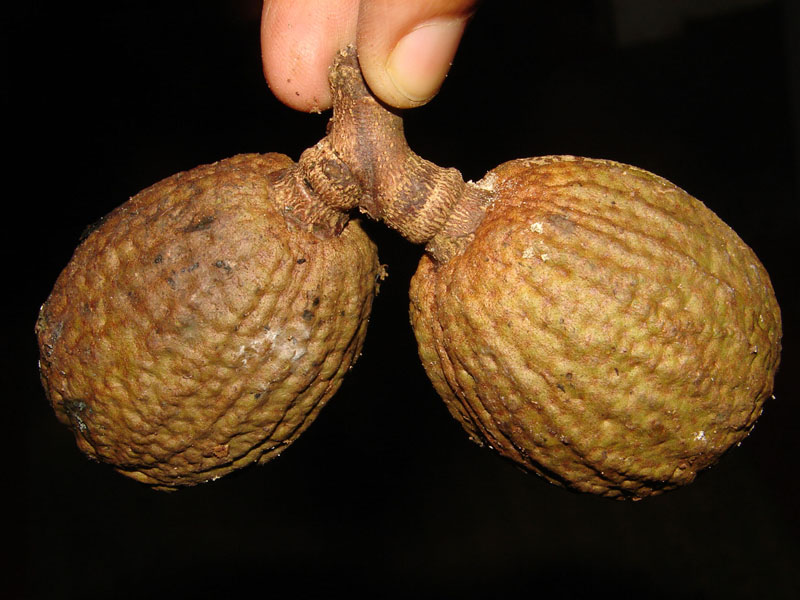
Common name: Chuvanna cheeralam, Chuvanna akil
Family: Meliaceae
Distribution:Endemic to southern Western Ghats
Conservation status: Critically Endangered (CR- IUCN Red list)
Description: Large trees. Leaves pinnate, leaflets 7-11, golden-red in flushing. Inflorescence axillary and terminal panicles, covered reddish-brown peltate scales. Fruit a large capsule, 3-5 cm diameter, ovoid. Seeds 1-3.
Uses: Not evaluated
Cynometra beddomei Prain
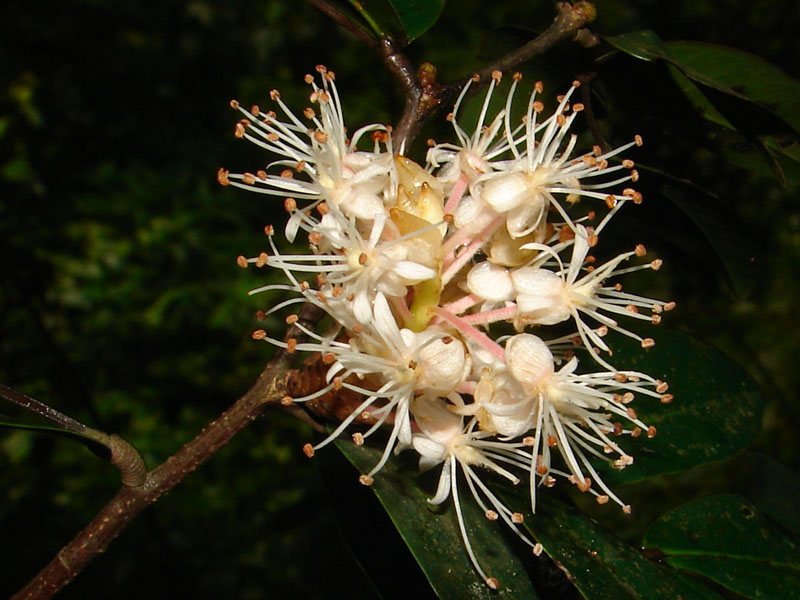
Common name: Valliyakoori
Family: Leguminosae- Caesalpinioideae
Distribution: Endemic to southern Kerala and Wayanad
Conservation status: Extinct (EX- IUCN Red list). But after this assessment, the plant was re-located from Agasthyamala 2002 and later from Wayanad. Scattered populations found.
Description: Medium sized tree. Leaves with 3 pair of leaflets, the lower pair small gradually largening to upper pairs, pinkish and drooping when young. Flowers creamy white in axillary clusters. Fruit a reniform-globose pod.
Uses: Highly ornamental in flushing and flowering
Dipterocarpus indicus Bedd.
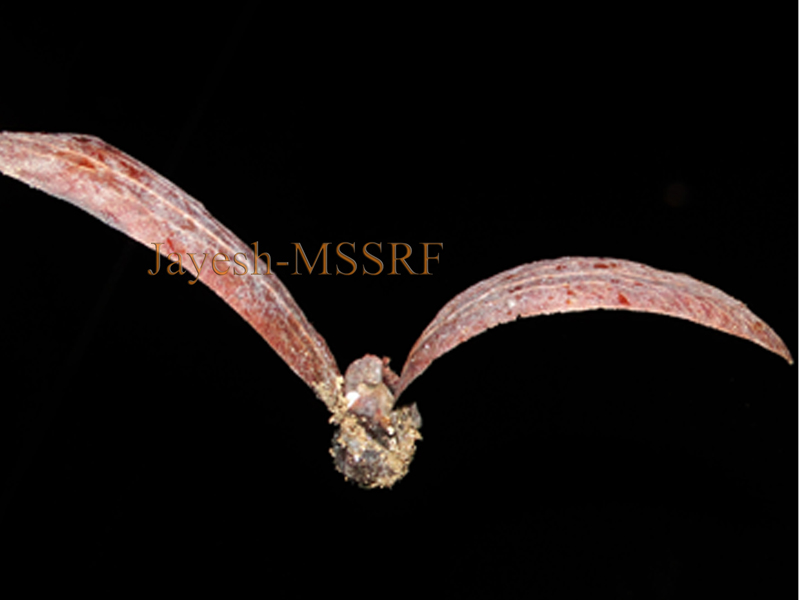
Common name: Kalpain, Karanjili
Family: Dipterocarpaceae
Distribution: Endemic to Western Ghats, throughout
Conservation status: Endangered (EN- IUCN Red list)
Description: Large evergreen trees, to 35 m height. Leaves large, ovate oblong, to 25 cm long, 10 cm wide. Flowers in axillary racemes, white. Fruit a hard nut, with wings formed of two accresent calyx lobes.
Uses: Timber
Hopea ponga (Dennst.) Mabb.
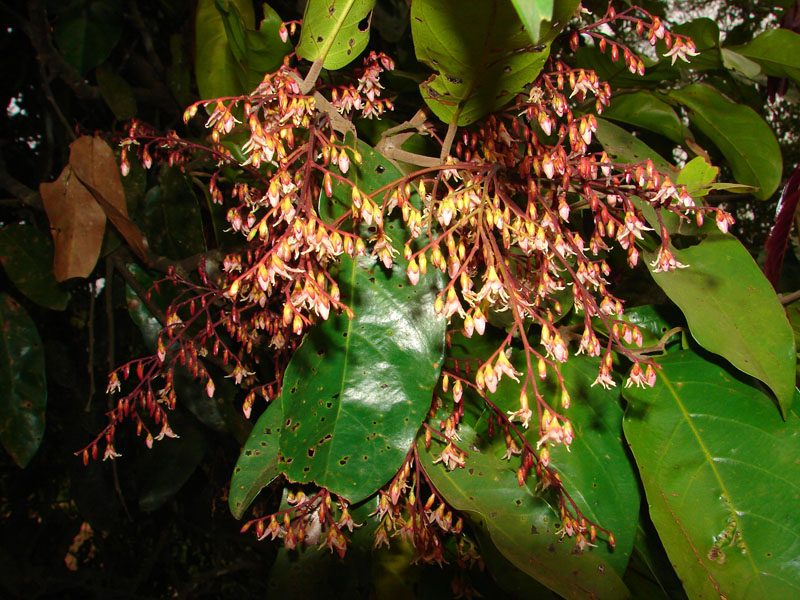
Common name: Kambakam, Neduvalipongu, Ilapongu
Family: Dipterocarpaceae
Distribution: Endemic, throughout Western Ghats, semi-evergreen forests
Conservation status: Endangered (EN- IUCN Red list)
Description: Small trees. Leaves large 10-15 cm long, 3-5 cm wide. Flowers white in axillary unilateral racemes; peduncle brown. Fruit n ovoid nut with two dark brown accresent calyx wings.
Uses: Timber, generally used for making agricultural implements.
Kingiodendron pinnatum (Roxb. Ex DC.) Harms

Common name: Kulavu, Ennapain
Family: Leguminosae-Caesalpinioideae
Distribution: Endemic to southern Western Ghats, throughout
Conservation status: Endangered (EN- IUCN Red list)
Description: Large evergreen trees. Leaves imparipinnate, leaflets 2-7, alternate. Inflorescence axillary and terminal panicles. Flowers white. Pod 1 seeded, ellipsoid, flattened.
Uses: Medicinal oil oozing from cut bark is highly medicinal
Cynometra travancorica Bedd.

Common name: Koori
Family: Leguminosae- Caesalpinioideae
Distribution: Endemic to Western Ghats in Karnataka, Tamil Nadu, Kerala
Conservation status: Endangered (EN- IUCN Red list)
Description: Evergreen trees. Leaves bifoliate. Flowers in short axillary and lateral racemes. Fruit 2-3 cm , flat, woody. Seed one
Uses: Ornamentally potential tree.
Atuna travancorica (Bedd.) Kosterm.
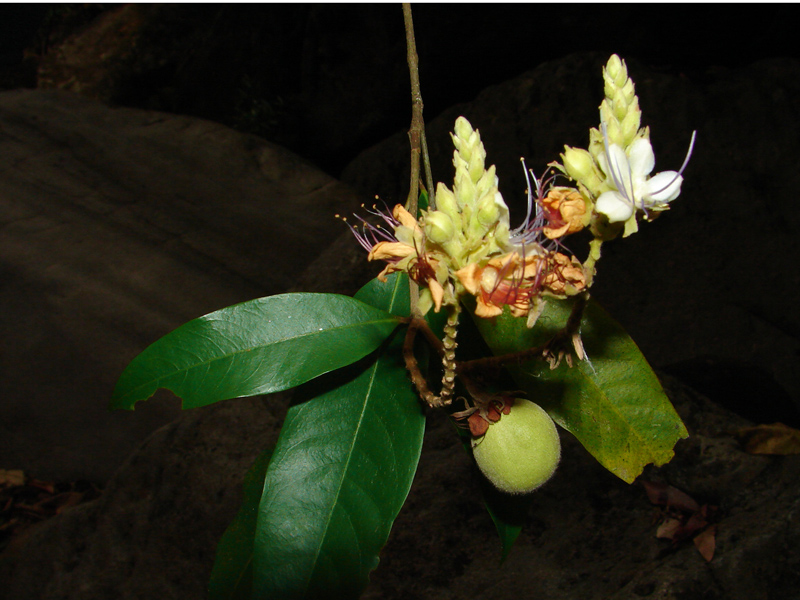
Common name: Kallankaimaram
Family: Chrysobalanceae
Distribution: Endemic to Western Ghats, Tamil Nadu, Kerala
Conservation status: Endangered (EN- IUCN Red list)
Description: Medium sized evergreen trees, Leaves simple, elliptic-lanceolate. Flowers pink in axillary racemes. Fruit a sub orbicular drupe, 2-3.5 cm long, 2-3 cm diameter, Seed 1-2.
Uses: Potential timber, ornamental
Madhuca bourdillonii (Gamble) H. J. Lam.
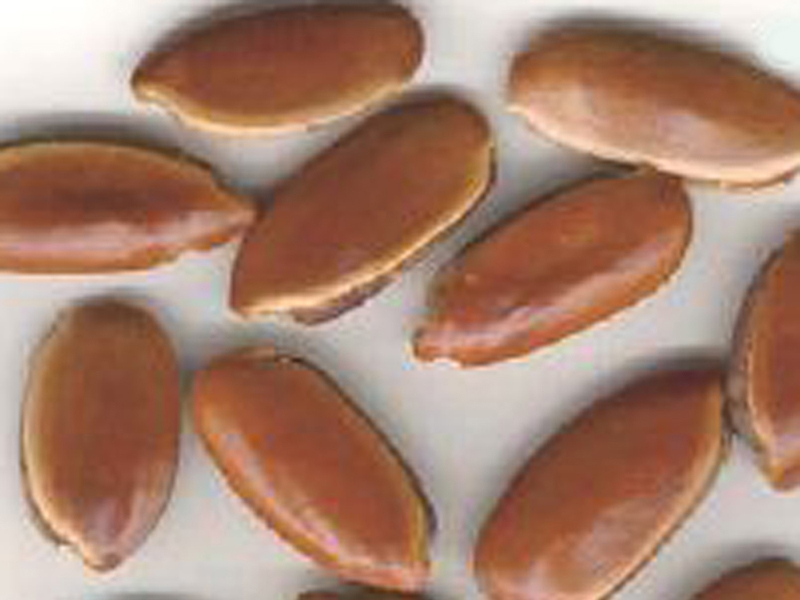
Common name: Ponavu, Thandidiyan
Family: Sapotaceae
Distribution: Endemic to southern Western Ghats
Conservation status: Endangered (EN- IUCN Red List)
Description: Large trees to 30 m tall. Young branches and leaves fulvous tomentose. Leaves large, to 30 cm long, 8 cm wide, spathulate, crowded to tip of branchlets. Flowers white, in axillary fascicles. Berry ovoid, 3-4 cm. Seeds 4-5.
Uses: Timber
Vateria indica L.
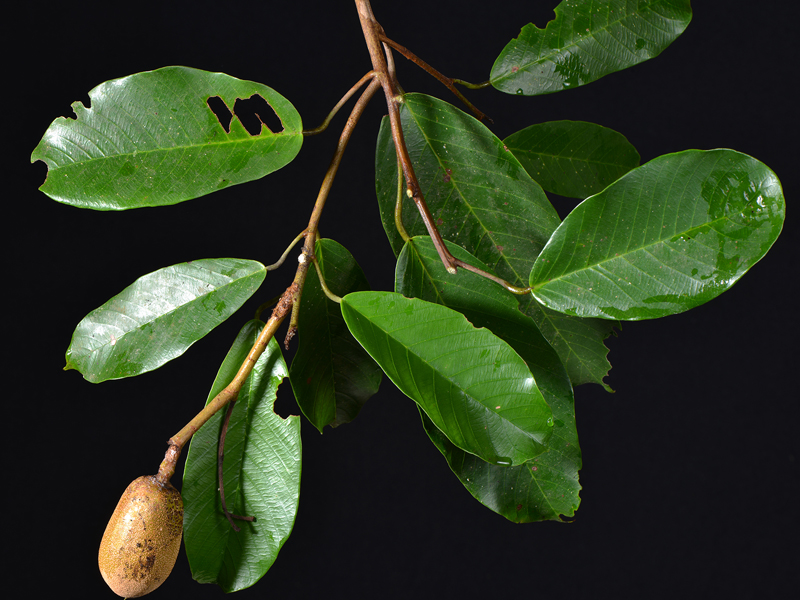
Common name: Vellapain, Velutha kunthitikkam, White dammar
Family: Dipterocarpaceae
Distribution: Endemic to Western Ghats, throughout, on river sides and plains near coastal areas.
Conservation status: Critically Endangered (CR- IUCN Red list)
Description: Large evergreen trees. Resin ooze from cut bark. Leaves large, oblong. Flowers white, in axillary panicles. Fruit ovoid oblong capsule, 5-10 cm long, 3-5 cm diameter.
Uses: Medicine, Soft wood, resin extracted is the white dammer, used as disinfectant, air purifier and mosquito repellent.
Hopea parviflora Bedd.
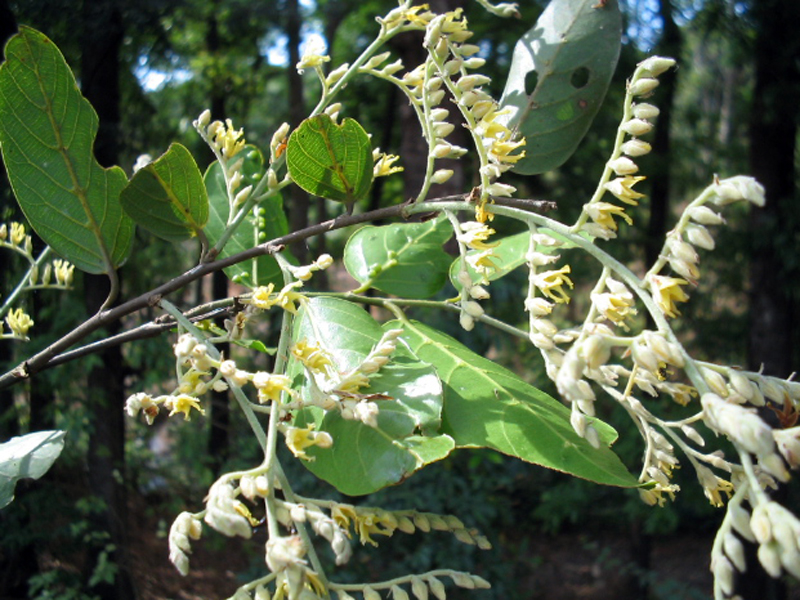
Common name: Irumbagam, Kambagam, Malabar Iron wood.
Family: Dipterocarpaceae
Distribution: Endemic to Western Ghats, in Karnataka, Tamil Nadu and Kerala.
Conservation status: Least concern (LC- IUCN Red list)
Description: Large trees, usually on the sides of rivers in medium to low altitudes. Bole straight, usually buttressed; wood very hard. Leaves small, with domatia at axils of lateral nerves. Flowers creamy yellow in unilateral axillary racemes. Fruit a nut with two wings of accrescent calyx.
Uses: High quality timber used for making railway sleepers in old days, building purposes.
Artocarpus hirsutus Lam.
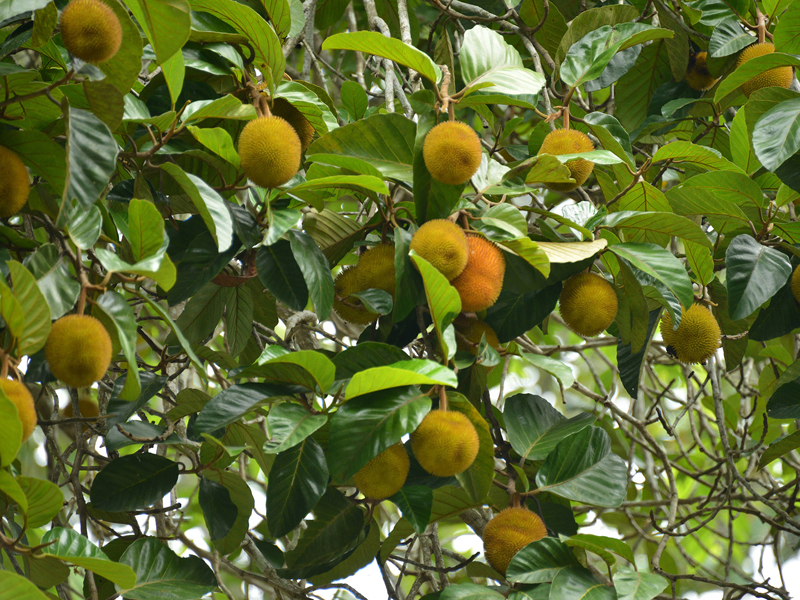
Common name: Anjili, Ayani, Wild Jack
Family: Moraceae
Distribution: Endemic to Western Ghats, throughout
Conservation status: Least Concern (LC- IUCN Red list)
Description: Large evergreen trees with straight bole. Milky latex present. Leaves large, broadly ovate elliptic, golden hairy below when young, covered by foliaceous bract in bud.Flowers unisexual, axillary spikes, male narrow, cylindric, female ovoid. Fruit a subglobose syncarp. Seed covered by orange red perianth, edible on ripening. Seed a nut.
Uses: Widely used Timber tree, often cultivated in homesteads. Fruits and roasted nuts edible, underutilized fruit , once widely used by ethnic and tribal community.
Arenga wightii Griffith
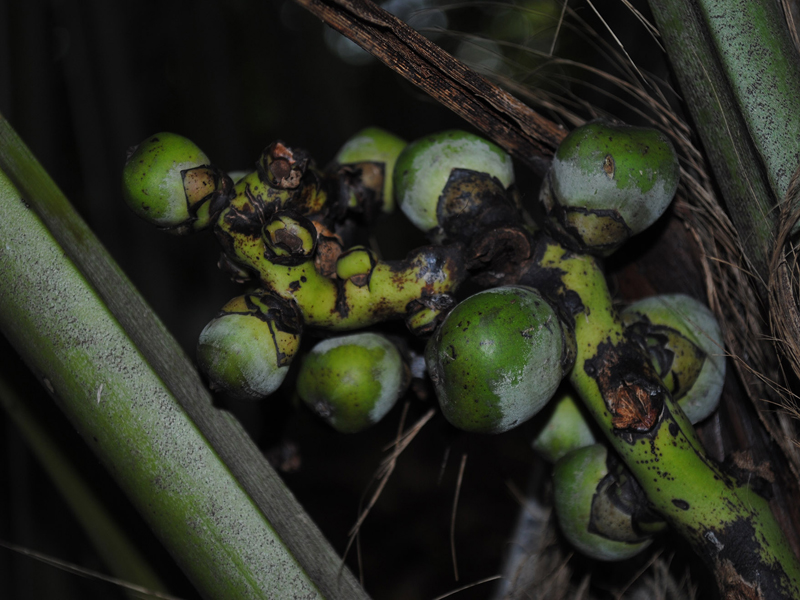
Common name: Njettipana, Kattuthengu
Family: Arecaceae
Distribution: Endemic to southern Western Ghats, throughout, in evergreen forests along stream sides.
Conservation status: Vulnerable (VU- IUCN Red list)
Description: Monoecious palms, to 6 m tall. Stem densely covered with persistant leaf sheaths. Leaves very large, pinnate, silvery coloured below. Male and female spadix separate, in dense clusters of drooping spikes, to 1 m long. Berry globose, 2-3 cm diameter, 3 seeded.
Uses: Leaves used for thatching by forest tribal communities. Toddy taped from inflorescence by tribals
Bentinckia condapanna A. Berry ex Roxb.
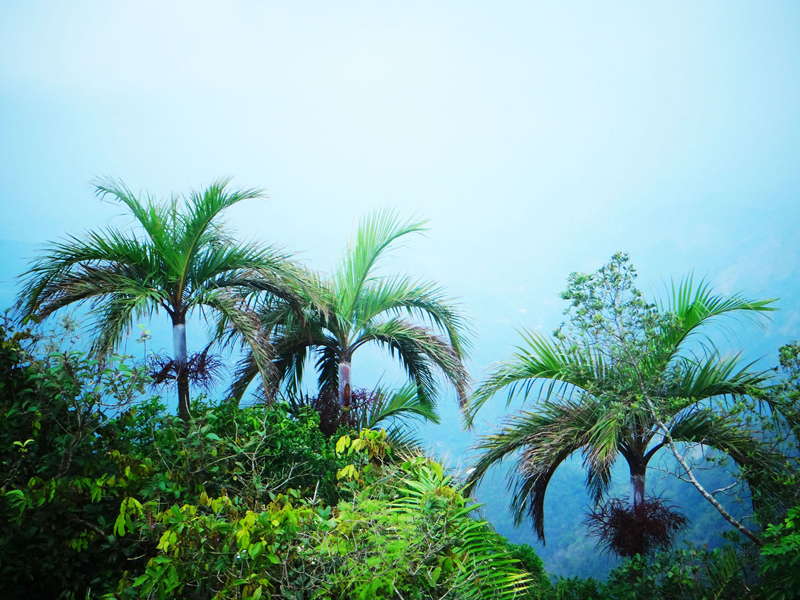
Common name: Kanthakamuku, Kanthapana, Parapakku
Family: Arecaceae
Distribution: Endemic to southern Western Ghats, south of Palakkad Gap, in Tamil Nadu & Kerala, always in on steep slopes of high altitudes.
Conservation status: Vulnerable (VU- IUCN Red list)
Description: Monoecious palm to 20 m tall. Leaves pinnate, clustered to tip, with sheathing petiole. Spadix branched from axils of fallen leaves below crown. Female flowers few at base of branches, male flowers to top. Ovary 3-celled, but only one cell with ovule, hence fruit 1-seeded.
Uses: Said to be tapped for toddy
Garcinia wightii T. Ander.
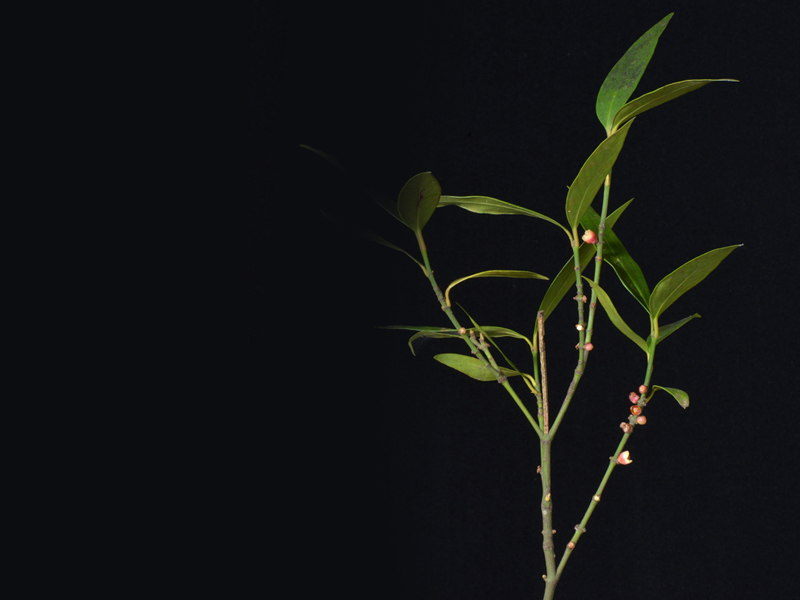
Common name: Pulimaranga
Family: Clusiaceae
Distribution: Endemic to southern Western Ghats
Conservation status: Vulnerable (VU- IUCN Red list)
Description: Small dioecious trees, on riversides. Latex yellow. Leaves linear lanceolate. Male flowers in axillary fascicles; female solitary, axillary.Fruit a globose berry, 1-1.5 cm diameter, Seeds 3-4.
Uses: Bark and fruits yield an yellow pigment.
Knema attenuata (Hook. f. & Thoms.) Warb.
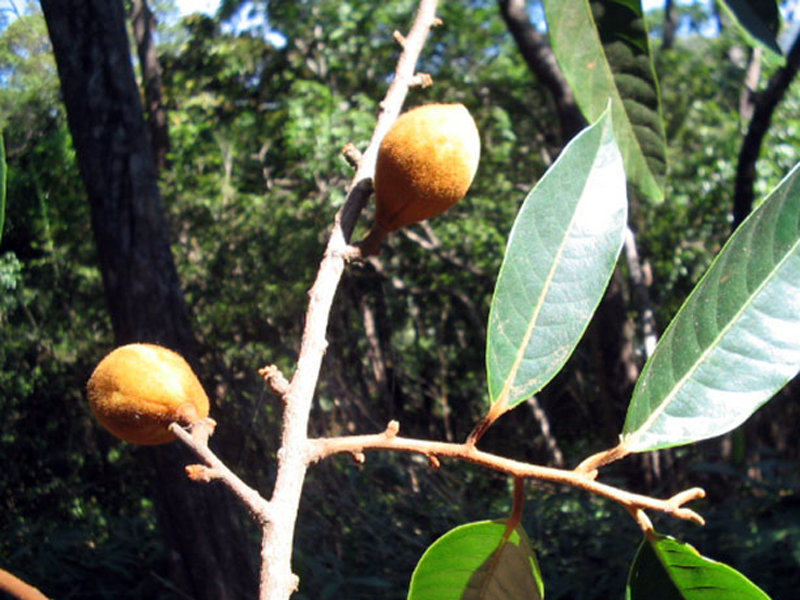
Common name: Chorapali, Chorapain
Family: Myristicaceae
Distribution: Endemic to southern Western Ghats, throughout in Myristica swampa and along stream sides.
Conservation status: Least concern (LC- IUCN Red list)
Description: Large dioecious trees. Sap blood red from cut bark. Branching whorled from main stem at intervals. Leaves elliptic lanceolate, golden hairy on back side. Male flowers axillary and laretal in few flowered short racemes. Female flowers 2-3 fascicled, axillary and lateral. Fruit ovoid, 2-valved capsule. Seed single. Aril red.
Uses: Soft wood, Medicinal.
Syzygium occidentale (Bourd.) Gandhi
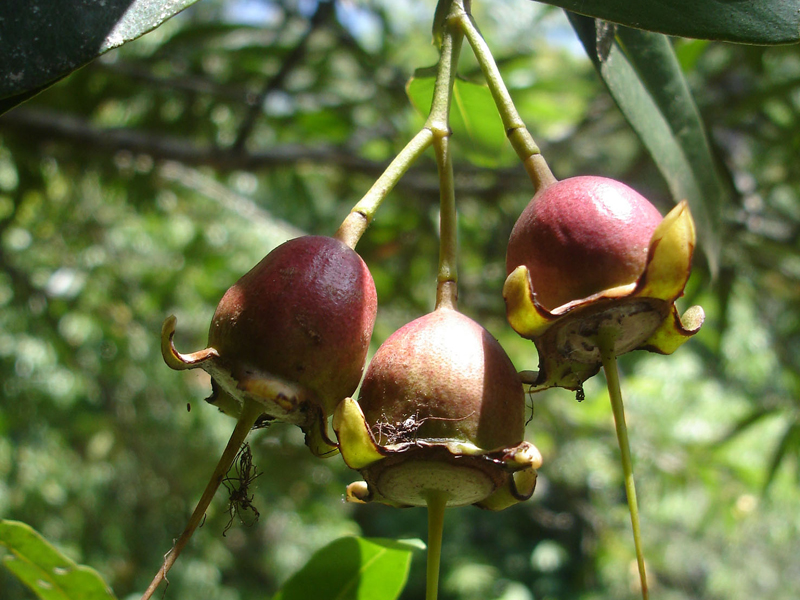
Common name: Attuchamba
Family: Myrtaceae
Distribution: Endemic to Southern Western Ghats, in revirine vegetation.
Conservation status: Vulnerable (VU- IUCN Red list)
Description: Small trees, on river sides. Leaves lanceolate. Flowers large in few flowered cymes, usually drooping, white, with indefinite stamens. Fruit a ovoid berry with persistent calyx and style. Seed 2-3.
Uses: Not evaluated
Myristica malabaricaLam.
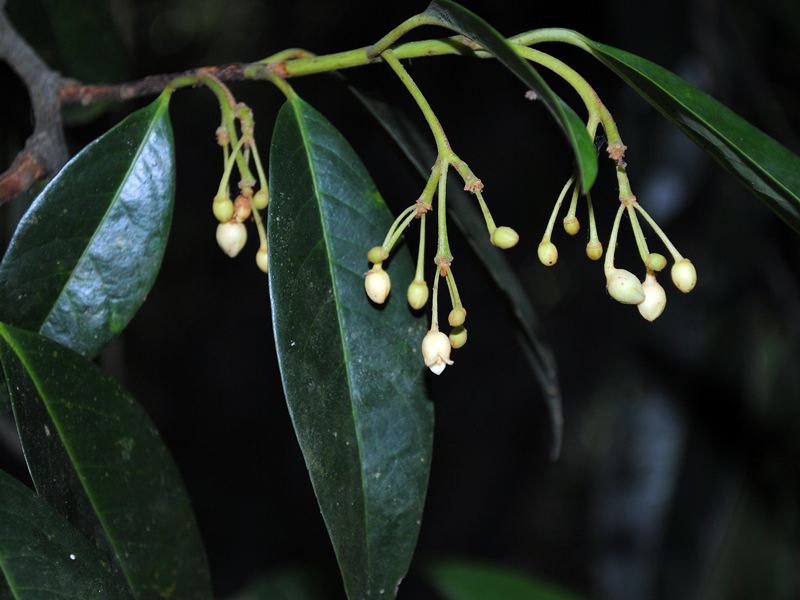
Common name: Kattujathy, Ponnampayin, Malabar Nutmeg
Family: Myristicaceae
Distribution: Endemic to Western Ghats in riverine evergreen forests and Myristica swamps.
Conservation status: Vulnerable (VU- IUCN- Red list)
Description: Large dioecious trees, buttressed and often with slit roots and pneumatophores. Exudate red from cut ends. Male flowers in axillary or lateral racemes. Female flowers in 3-5 flowered terminal umbels. Capsule large oblong5-7 cm long, 2-3 cm diameter, 2-valved, densely brown pubescent out. Seed one, oblong, brownish, 4-5 cm long, 1-2 cm diameter. Aril yellow.
Uses: Medicinal
Cinnamomum riparium Gamble
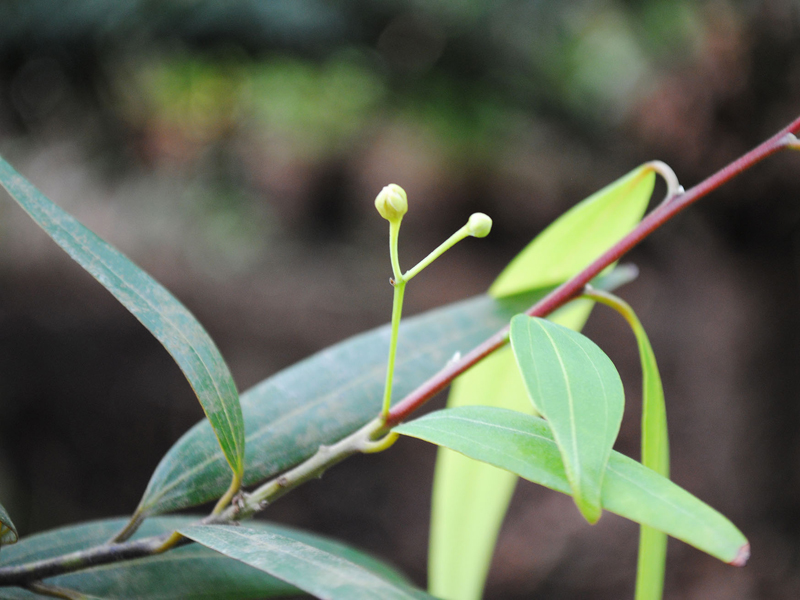
Common name: Aatuvayana
Family: Lauraceae
Distribution: Endemic to southern Western Ghats, along stream sides
Conservation status: Vulnerable (VU- IUCN Red list)
Description: Evergreen tree. Leaves linear-lanceolate. Inflorescence few flowered axillary and lateral cymes. Fruit a small one seeded berry.
Uses: Not evaluated
Ochreinauclea missionis (Wall. Ex G. Don) Ridsd.
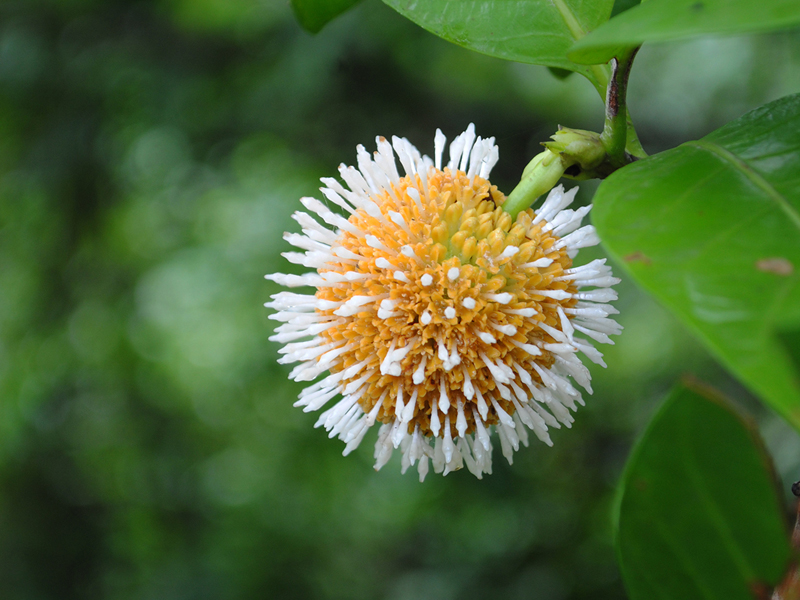
Common name: Aatuvanchi, Neervanchi
Family: Rubiaceae
Distribution: Endemic to southern Western Ghats, in revirine vegetation
Conservation status: Vulnerable (VU- IUCN Red list)
Description: Medium sized evergreen trees. Leaves broadly lanceolate, shining green. Flowers yellow in terminal tennis ball like heads. Fruit minute, clustered in a globose fleshy mass. Seeds minute.
Uses: Medicinal
Buchanania lanceolata Wt.
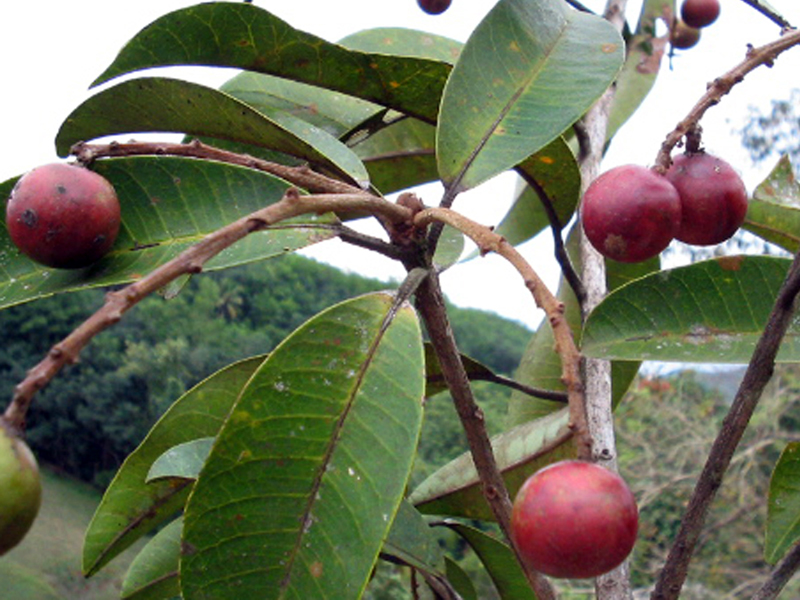
Common name: Kulamavu, Malamavu
Family: Anacardiaceae
Distribution: India, Myanmar
Conservation status: Vulnerable (VU- IUCN Red list)
Description: Medium sized evergreen trees. Leaves lanceolate, clustered to end of branchlets. Flowers small, white in terminal racemose panicles. Fruit a drupe, compressed globose, to 1 cm diameter. Seed single, stony.
Uses: Kernel edible
Semecarpus auriculata Bedd.
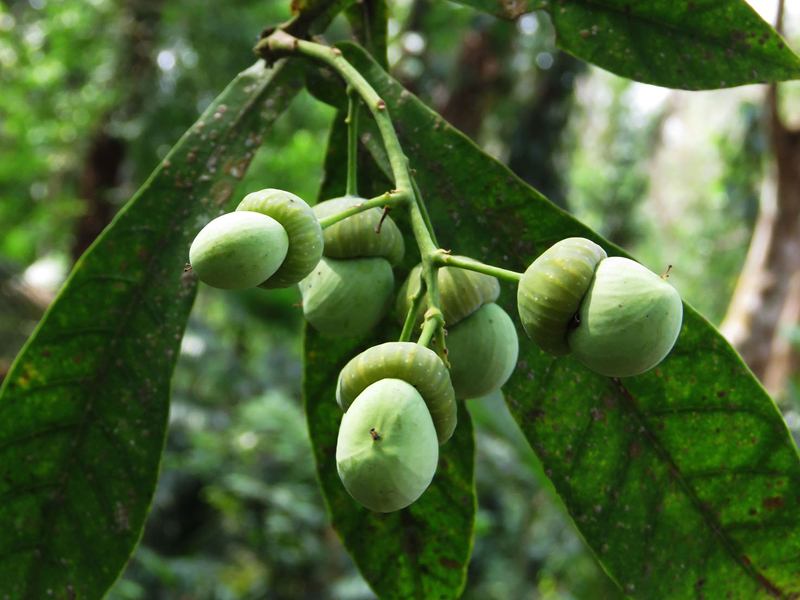
Common name: Mamcheru, Vellacheru
Family: Anacardiaceae
Distribution: Endemic to southern Western Ghats
Conservation status: Near Threatened (NT- IUCN Red list)
Description: Large evergreen trees, with acridc sap. Leaves clustered at tip of branchlets, spathualte, auricled at base. Flowers small, white in axillary panicles. Drupe 1cm diameter, compressed, stony, seated on fleshy hypocarp.
Uses:Soft wood
Humboldtia decurrens Bedd. ex Oliver
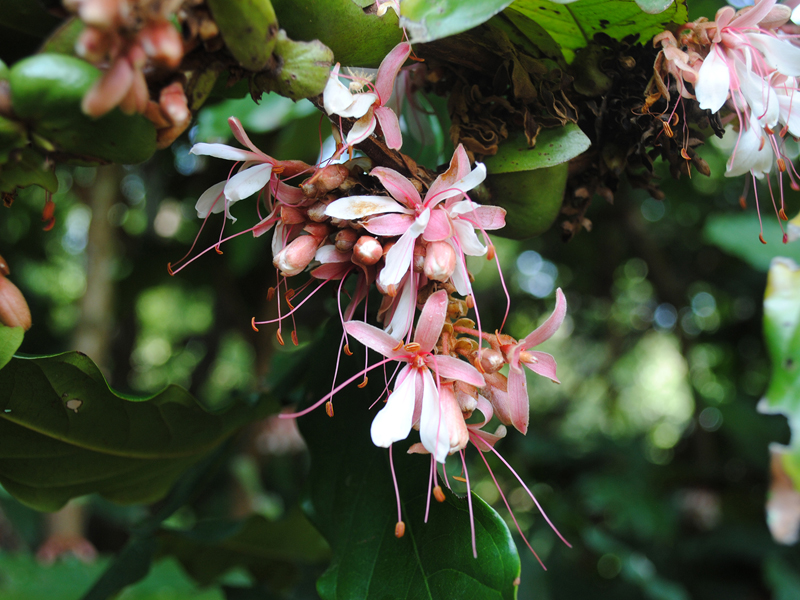
Common name: Kattasokam
Family: Leguminosae-Caesalpinioideae
Distribution: Endemic to southern Western Ghats, in Agasthyamala Biosphere Reserve. Very rare in scattered populations.
Conservation status: Near Threatened (NT- IUCN Red list)
Description: Small trees in evergreen forests at low elevations. Leaves pinnate, leaflets 5 pairs, drooping when young. Stamens long exsertd. Flowers pinkish white, in dense axillary and lateral fascicles, drooping. Pod compressed, 2-5 seeded.
Uses: Tree with high ornamental potential.
Gymnacranthera canarica (Bedd. ex King) Warb.
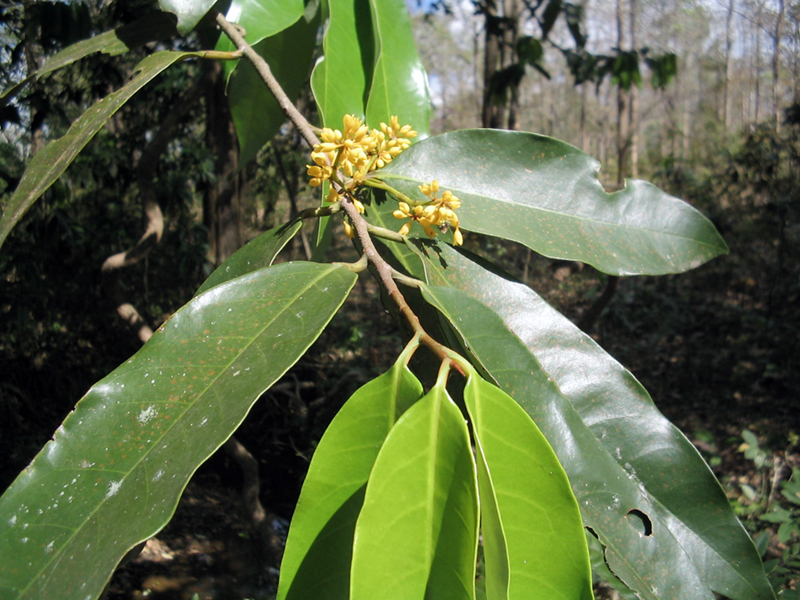
Common name: Undapayin
Family: Myristicaceae
Distribution: Endemic to southern Western Ghats near streams and Myristica swamps
Conservation status: Vulnerable (VU- IUCN Red list)
Description: Medium sized dioecious trees. Leaves elliptic, acuminate. Male flowers yellow, in axillary panicles. Female flowers few flowered axillary fascicles. Capsule globose, 2-3 cm diameter. Seed one, globose, 2-2.5 cm diameter. Aril reddish.
Uses: Not evaluated, aril used as adulterant of official mace.
Elaeocarpus munroniiWt.
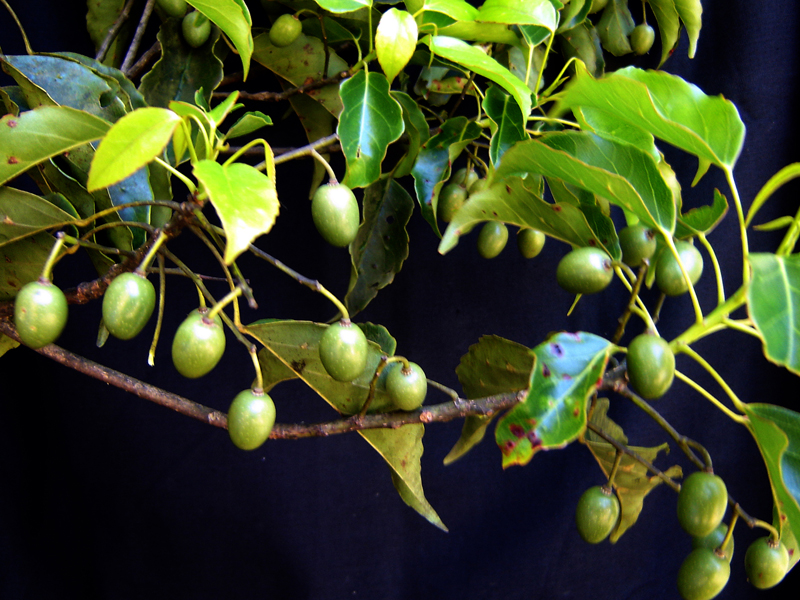
Common name: Kalrudraksham
Family: Elaeocarpaceae
Distribution: Endemic to southern and Central Western Ghats
Conservation status: Near threatened (NT- IUCN Red list)
Description: Evergreen trees of high altitude.Leaves clustered to tip of branchlets, red on ageing. Flowers white in drooping axillary racemes. Drupe oblong, terete, 2 cm long, bluish on ripening. Seeds 1-2.
Uses: Not evaluated
Tabernaemontana heyneanaWall.
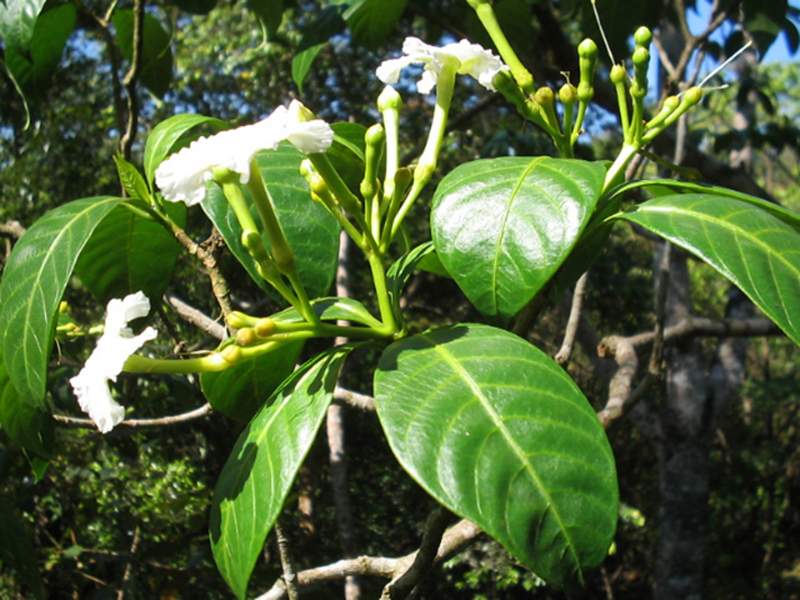
Common name: Kundalapala, Koonampala
Family: Apocynaceae
Distribution: Endemic to the Western Ghats
Conservation status: Near Threatened (NT- IUCN Red List)
Description: Small deciduous trees. Milky latex present. Leaves opposite with unequal pairs. Flowers white in terminal cymes. Fruits of two boat shaped recurved follicles. Seeds orange red arillate.
Uses: Medicinal
Hydnocarpus macrocarpa (Bedd.) Warp.
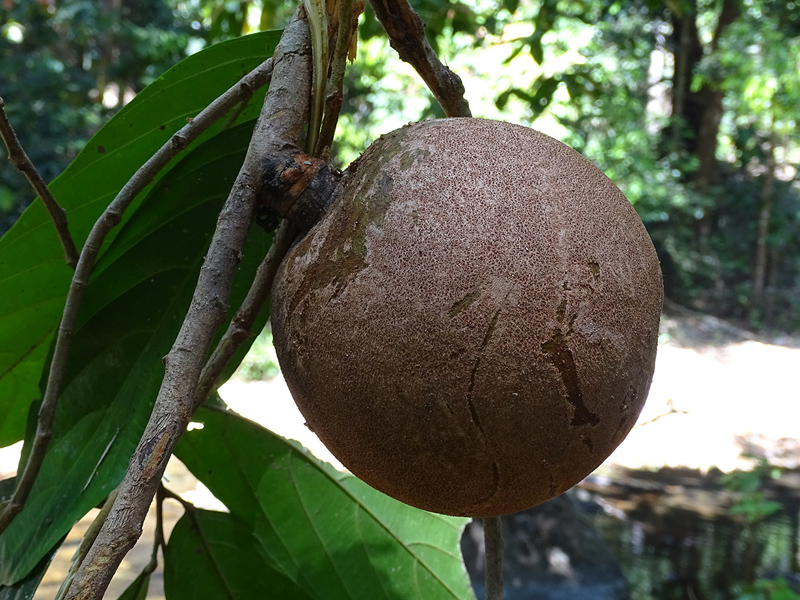
Common name: Malamarotty
Family: Flacourtiaceae
Distribution: Endemic to Western Ghats
Conservation status: Vulnerable (VU- IUCN Red List)
Description: Large evergreen trees, mainly riparian. Leaves large, oblong, dark green. Flowers in fascicles on leafless branches, white with hairy brown calyx. Fruit a large globose berry, to 15 cm diameter.
Uses: Medicinal
Nothopegia aureo-fulva Bedd. ex Hook. f.
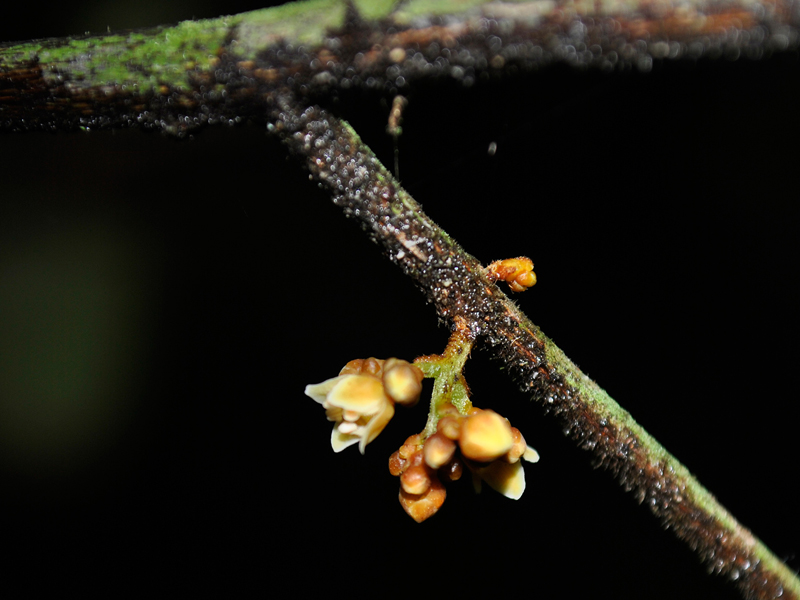
Common name
Family: Anacardiaceae
Distribution: Endemic to Southern Western Ghats
Description: Small trees in evergreen forests. The young branches, petioles and peduncles golden rusty fulvous. Leaves elliptic lanceolate, acuminate, fulvous hairy on nerves below. Flowers in axillary small cymose panicles. Drupe globose, 1-1.2 cm diameter, 1-seeded.
Uses: Not evaluated
Garcinia travancorica Bedd.
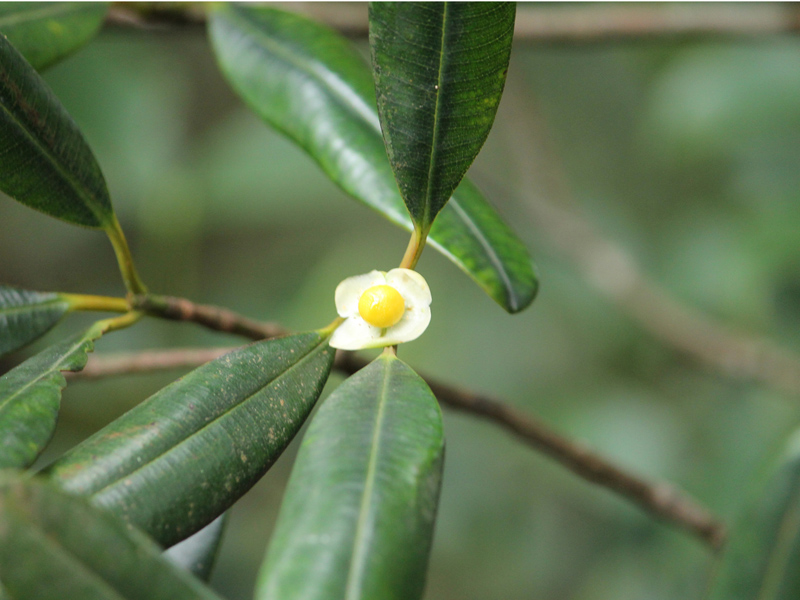
Common name: Malampongu
Family: Clusiaceae
Distribution: Restrictedly endemic to Agasthyamala Biosphere Reserve
Conservation status: Vulnerable (IUCN Red List)
Description: Medium sized evergreen dioecious trees of higher altitudes. Exudate milky. Leaves narrowly elliptic-oblong, shining, parallel nerved, revolute on margins. Flowers white. Male flowers in terminal trichotomous cymes. Female flowers solitary in upper axils. Fruit an erect subglobose berry, with a persistent discoid stigma. Seeds 1-2.
Uses: Resinous gum medicinal.
Garcinia imberti Bourd.

Common name: Manjakkanji
Family: Clusiaceae
Distribution: Restricted endemic to Agasthyamal Biosphere Reserve
Conservation status: Endangered (EN- IUCN Red List)
Description: Medium sized evergreen dioecious trees of higher altitudes. Exudation white. Leaves dark green, oblanceolate, acuminate at apex. Flowers yellow, male usually 3-5 in terminal fascicles. Female usually solitary, terminal. Fruit an ovoid, laterally compressed 2-loculed berry, with a beaked apex, rarely one loculed. Seeds 1-2.
Uses: Not evaluated
Garcinia indica(Thouras) Choisy

Common name: Punnampuli, Kokkam
Family: Clusiaceae
Distribution: Endemic to Northern Western Ghats, introduced to many parts of Asia, Europe.
Conservation status: Vulnerable (VU- IUCN Red List)
Description: Medium sized evergreen dioecious tree with milky exudate. Branchlets drooping. Leaves reddish when young, obovate-oblong. Flowers greenish-white, male 4-8 in axillary and terminal fascicles, female solitary, terminal. Berry globose, smooth, 2-4 cm diameter, green turning red on ripening,4-8 loculed and seeded.
Uses: A highly utilized medicinal plant. The kOKum butter taken from the seeds is a source of Hydrocitric acid an anti-obesity medicine, widely used.
Myristica beddomei subsp. sphaerocarpa de Wilde
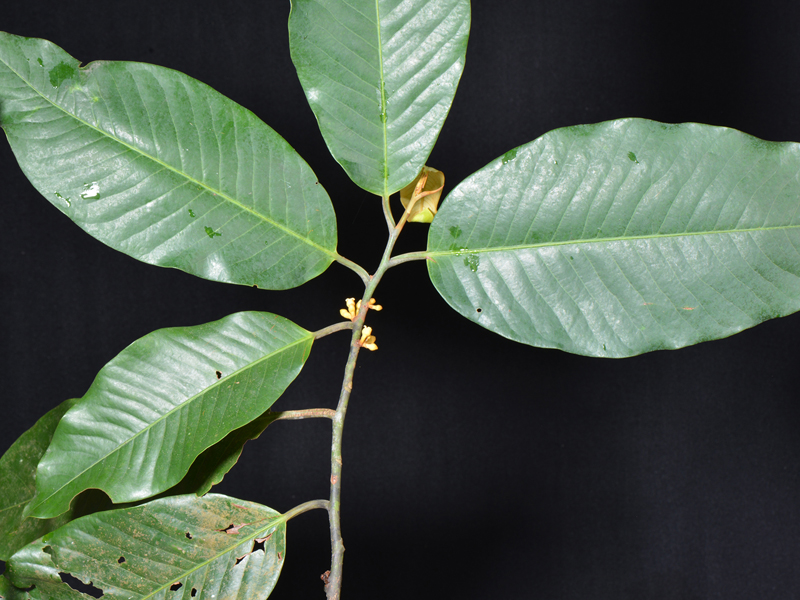
Common name: Undapayin
Family: Myristicaceae
Distribution: Endemic to southern Western Ghats
Conservation status: Endangered (EN- IUCN Red List)
Description: Medium sized dioecious trees. Leaves 7-12x 3-4 cm, ovate elliptic, green shining. Flowers small, brown hairy, 3-5 fascicled axillary or on scars of fallen leaves. Capsule globose, 3-4 cm diameter. Seed one, globose.
Uses: Medicinal
Psydrax dicoccos Gaertn.
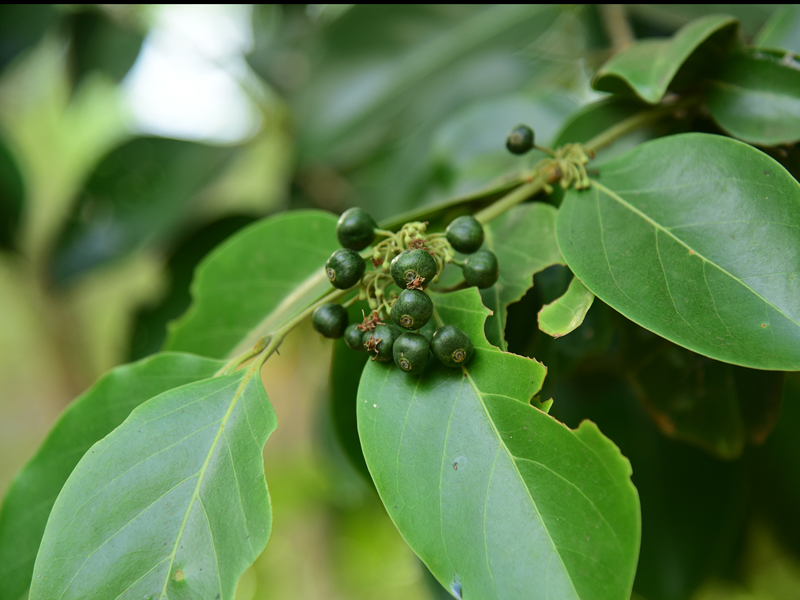
Common name: Irumbarappan
Family: Rubiaceae
Distribution: Indo-Malesia, China
Conservation status: Vulnerable (VU- IUCN Red List)
Description: Small evergreen trees. Leaves ovate to ovate-lanceolate. Flowers white, in axillary fascicled cymes. Fruit a compressed globose drupe of two pyrenes.
Uses: Very hard wood used for making handles for agricultural implements.
Calophyllum apetalum Willd.
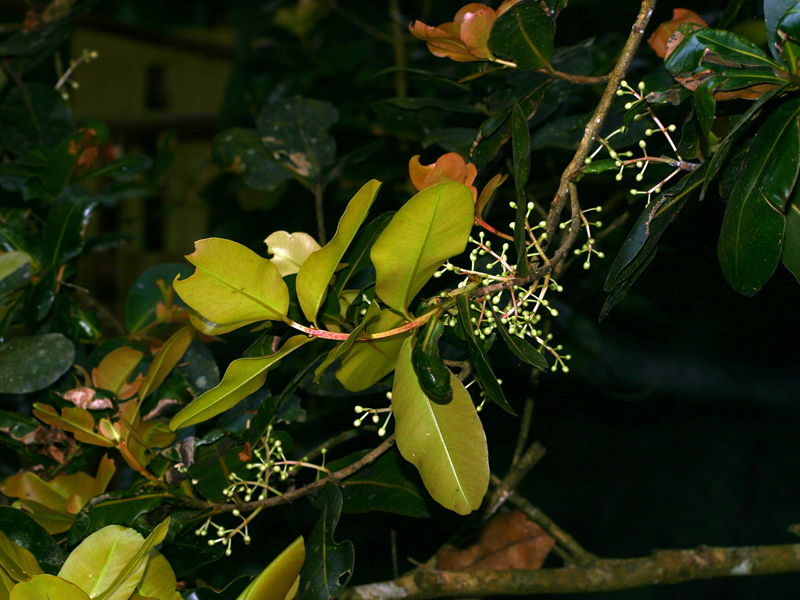
Common name: Attupunna, Cherupunna
Family: Clusiaceae
Distribution: Endemic to Western Ghats on river banks
Conservation status: Vulnerable (VU- IUCN Red List)
Description: Large evergreen trees. Bark yellowish, fissured. Leaves obovate-round, thick, closely parallel veined. Flowers white, in axillary racemose panicles. Drupe globose, 0.5-0.8 cm diameter. Seed single.
Uses: Medicinal
Santalum album L.

Common name: Chandanam, Shrikhand.
Family:Santalaceae
Distribution: India, Malesia
Conservation status: Vulnerable (VU- IUCN Red List)
Description: Medium sized evergreen trees of dry areas. Leaves simple opposite, elliptic ovate. Inflorescence terminal and axillary paniculate cymes. Flowers cream turning brown on ageing.Fruit a globose drupe, 0.4-0.5 cm diameter, green turning dark purple on ripening.
Uses: Heartwood yields the most valuable perfumery oil Santal oil. Medicinal and also religious plant.
Calophyllum inophyllum Linn.
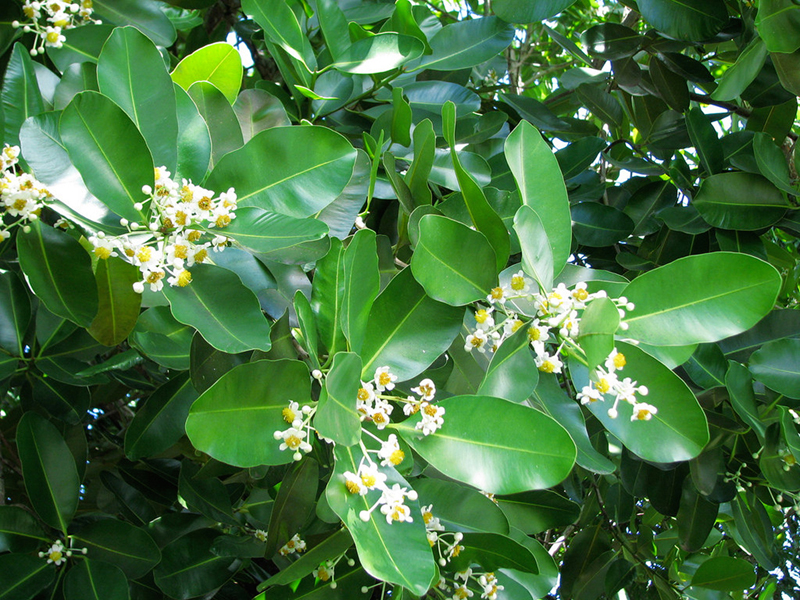
Common name: Punnag, Punna
Family: Clusiaceae
Distribution: Asia, Africa, Australia
Conservation status: Least concerned (LC- IUCN Red List)
Description: Medium sized trees, in plains, stream sides and as mangrove associate. Leaves broadly elliptic –oblong, parallel veined. Inflorescence axillary racemes. Flowers white, showy with many yellow stamens. Drupe globose, 1.5-2 cm diameter.
Uses: Medicinal
Saraca asoca (Roxb.) de Wilde
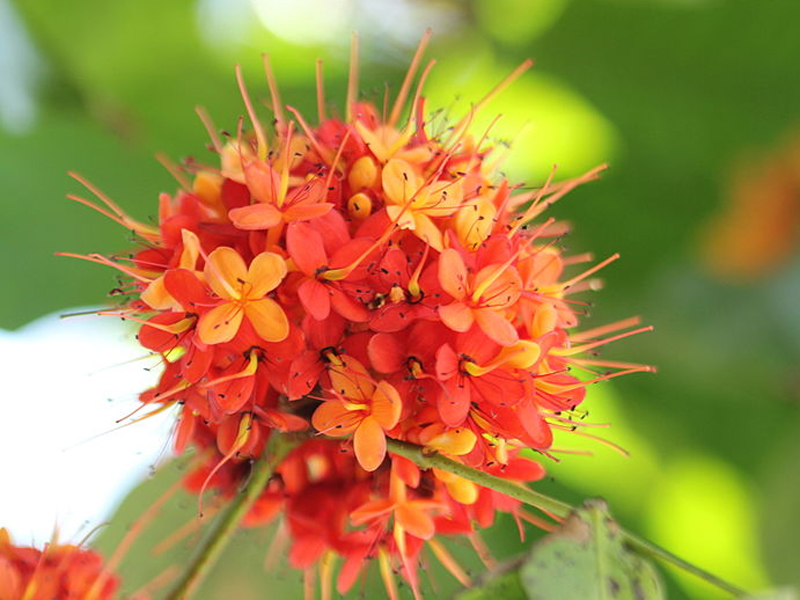
Common name: Asokam
Family: Leguminosae-Caesalpinioideae
Distribution: Indo- Malaya
Conservation status: Vulnerable (VU-IUCN Red List)
Description: Small trees. Leaveas pinnate. Flowers reddish in dense axillary and caulifloroous cymose panicles. Petal absent. Pod falat compressed, 8-12 x 2-2,5 cm. Seeds discoid, 1.5-2 cm diameter.
Uses: Highly medicinal
ENDEMIC PLANTS
Memecylon randeriana S. M. Almeida & M. R. Almeida

Common name:Kasavu
Family:Melastomataceae
Distribution: Endemic to Western Ghats
Conservation status: Not Evaluated
Description: Large shrubs or small trees. Leaves lanceolate, round to cordate at base. Flowers blue, densely fascicled axillary or on leafless stem. Berry globose red on ripening.
Uses: Ornamental
Semecarpus travancorica Bedd.
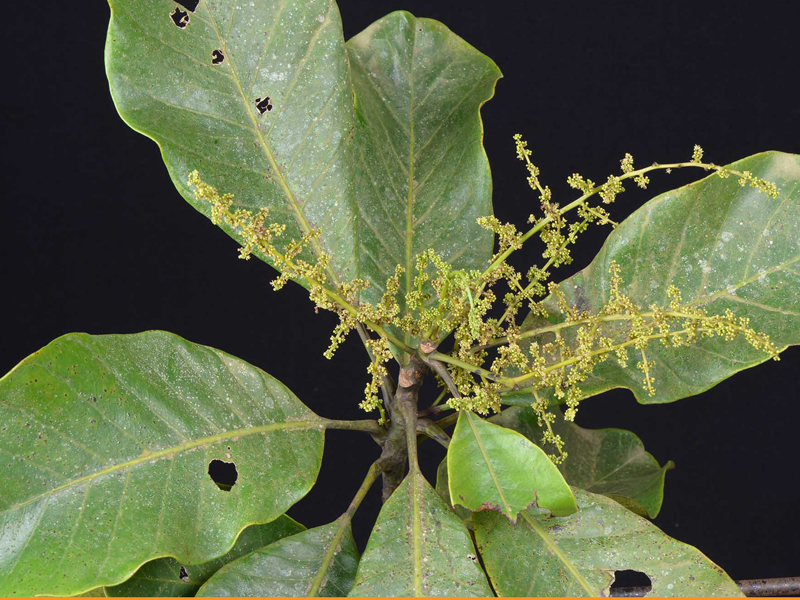
Common name: Avukkaram
Family:Anacardiaceae
Distribution:Endemic to southern Western Ghats
Conservation status: Not Evaluated. (Vulnerable- India Biodiversity Portal)
Description:Large evergreen trees, with acrid exudation, black on drying. Leaves very large, to 30 cm long, 10 cm wide, spathulate-oblong, crowded at tip of branchlets. Flowers small, greenish-yellow, in axillary and terminal panicles. Fruit 3-4 cm, a stony drupe, compressed and placed on fleshy hypocarp.
Uses: Medicinal
Garcinia gummigutta var. conicarpa (Wt.) N. P. Singh
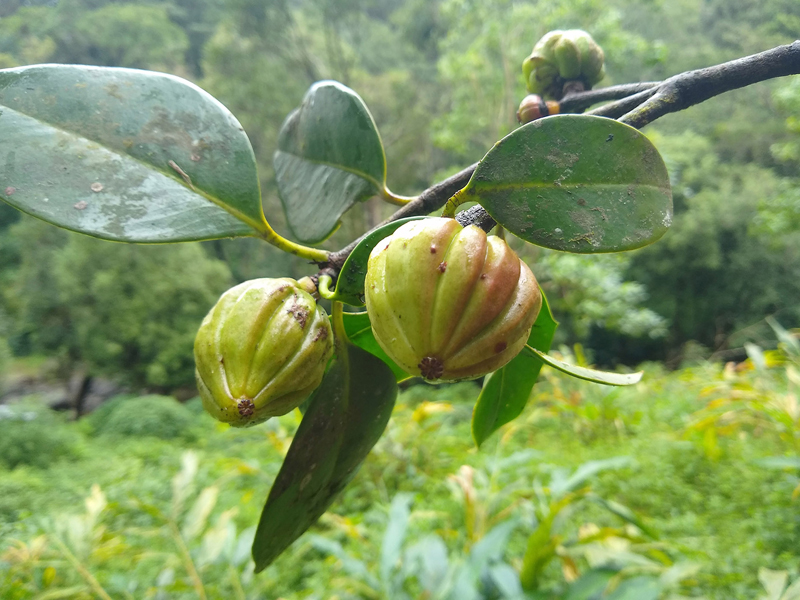
Common name: Kudampuli
Family: Clusiaceae
Distribution: Restricted endemic of Wayanad and Nilgiri hills
Conservation status: Not Evaluated
Description: Medium sized dioecious trees. Leaves roundish-eliptic. Male flowers yellow, in axillary and lateral fascicles. Female flowers solitary, terminal. Fruit conical, 4-5 ridged. Seeds 4-5
Uses: Used as an edible fruit in curries
Goniothalamus wightiiHook. F. & Thoms.
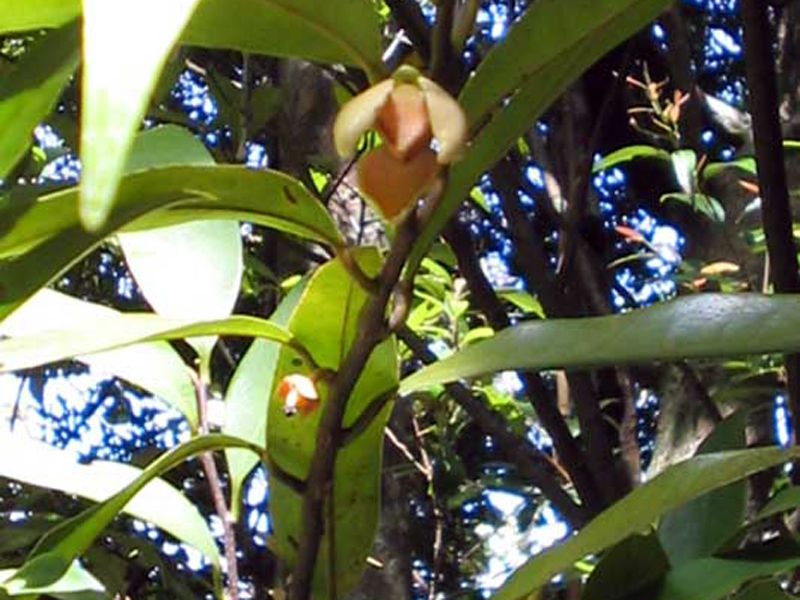
Common name: Malamthelli
Family:Annonaceae
Distribution: Endemic to southern Western Ghats
Conservation status: Not evaluated
Description: Small trees. Leaves linear-lanceolate. Flowers solitary, axillary, greenish-purple. Fruit aggregate of single seeded berries.
Uses: Not evaluated
Bacccaurea courtallensis (Wt.) Muell.-Arg.
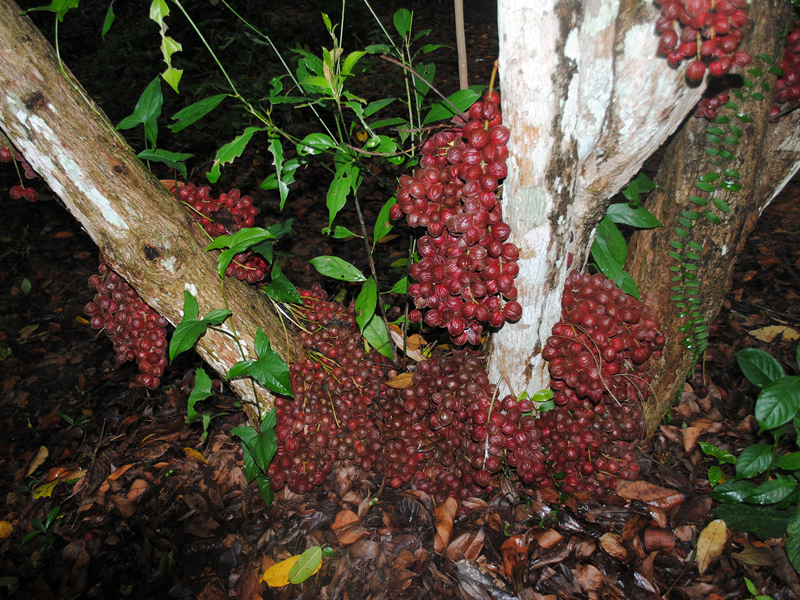
Common name: Mooty maram
Family: Euphorbiaceae
Distribution: Endemic to southern Western Ghats
Conservation status: Not evaluated
Description: Small dioecious evergreen trees. Leaves ovate-lanceolate, clustered to tip of branches. Male flowers red, formed on old strm in dense spikate racemes. Female flowers in clustered spicate racemes, mainly towards the base of the trunk. Fruit a subglobose capsule, 2-3 cm diameter. Seeds 1-3, with fleshy aril.
Uses: Edible
Kunstleria keralensis C. N. Mohanan & N. C. Nair
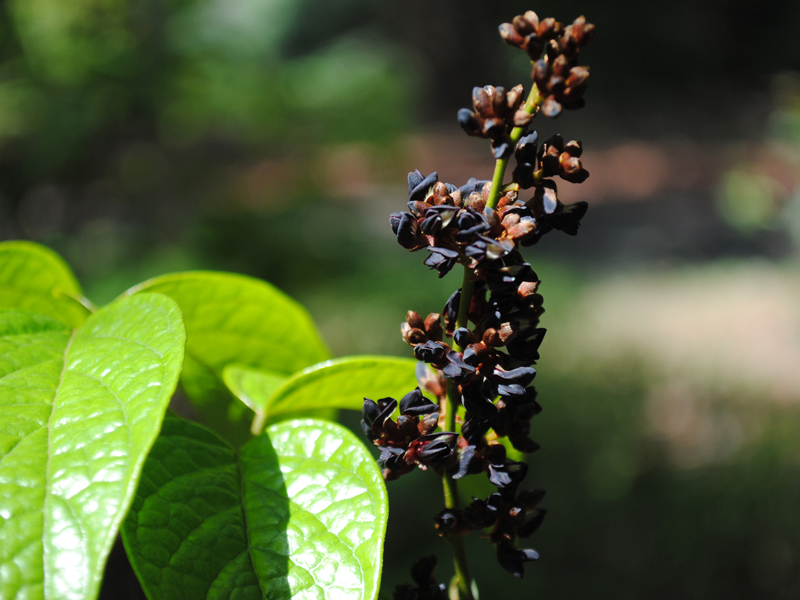
Common name: Kariveppila Valli
Family: Leguminosae
Distribution:Endemic to southern Western Ghats
Conservation status: Not Evaluated
Description: Large woody climbers. Leaves pinnate, ovate-oblong, rugose-reticulate. Flowers black to dark brown in terminal and axillary racemose panicles. Peduncle and calyx rusty tomentose.Pod flat, 1-seeded.
Uses:
Ormosia travancorica Bedd.
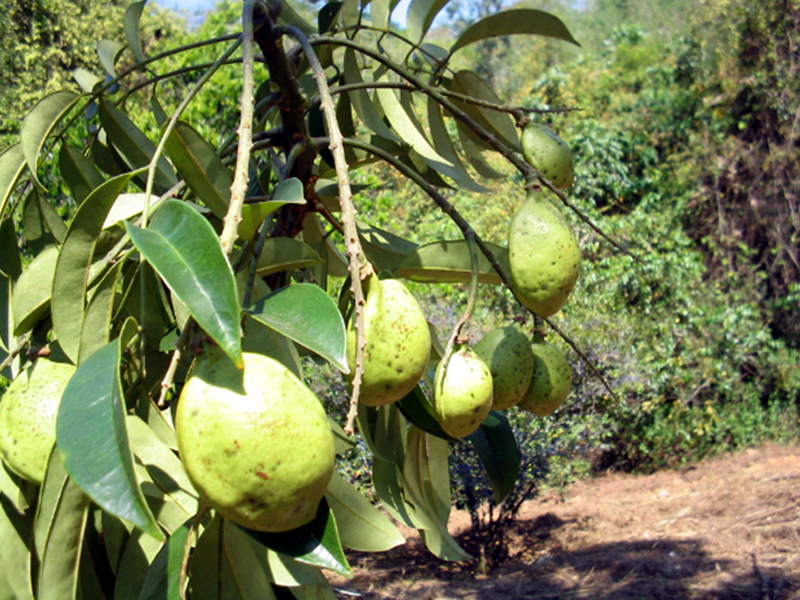
Common name: Mala-manchadi
Family: Leguminosae-Papilionoideae
Distribution: Endemic to Western Ghats
Conservation status: Not evaluated
Description:Large evergreen trees. Leaves imparipinnate, clustered to end of branchlets. Flowers in axillary racemes, pale pinkish. Pod woody, elliptic, compressed. Seed 1-1.5 cm diameter, discoid, scarlet red.
Uses:
Humboldtia brunonis Wall.

Common name: Malayasokam
Family: Leguminosae-Caesalpinioideae
Distribution:Endemic to southern Western Ghats
Conservation status: Not Evaluated
Description: Small trees. Leaves paripinnate, with two pairs of leaflets, drooping when young. Domatia present. Stipules auricled at base. Flowers pinkish in short erect axillary and lateral racemes. Pod flat, woody, 7×3 cm, 2-3 seeded.
Uses: Highly ornamental
Syzygium munronii (Wt. ) Chandr.
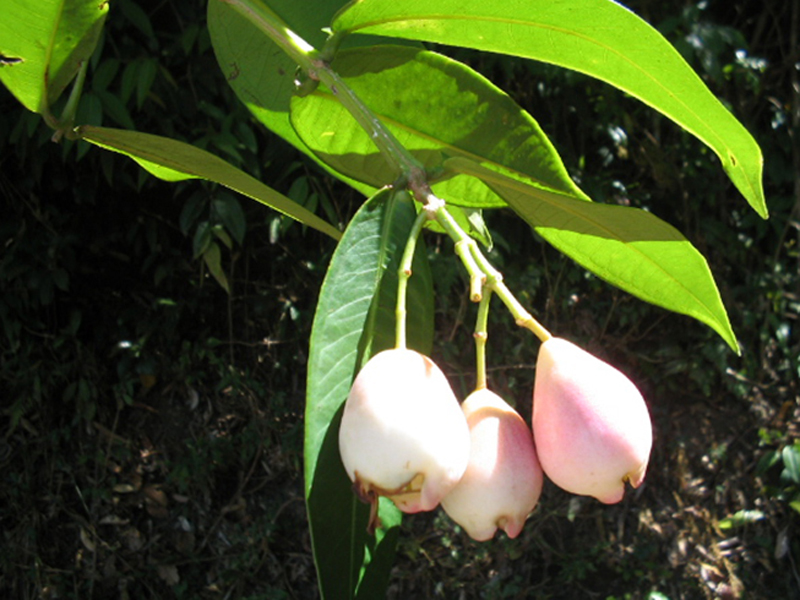
Common name: Mala chamba
Family: Myrtaceae
Distribution: Endemic to Western Ghats
Conservation status: Not Evaluated
Description: Small trees. Leaves lanceolate, gradually narrowing to acuminate tip; midrib canaliculated above. Flowers large in terminal few flowered cymes, drooping, stamens many much exserted. Berry large to 4cm, greenish-pink with persistant calyx.
Uses:
https://mssbg.mssrf.org/100-trees-list-selected-for-mssbg-conservation/
100 Trees list selected for MSSBG Conservation
